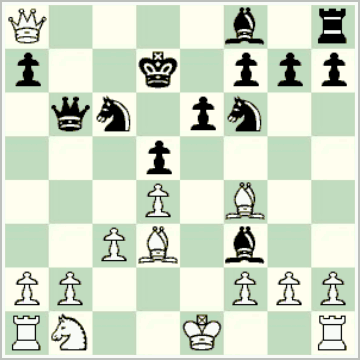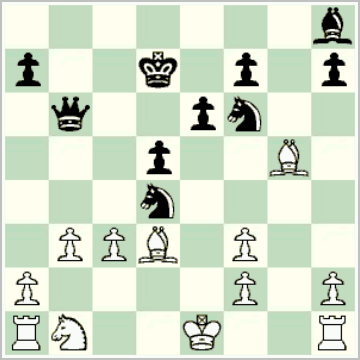One of the interesting aspects of chess history is that missing games from long-ago events turn up out of the blue, rediscovered in some out-of-the-way publication.
One such game appeared this very month, discovered by “Tabanus” at chessgames.com and relayed via BritBase: the game between Irish champion John J. O’Hanlon and Roland H. V. Scott from the British Championship 1921.
This appeared the following day in the Westminster Gazette, August 18, 1921 p. 6, under the heading “A Lively Skirmish”, and the game itself doesn’t disappoint.

11. ?
The anonymous editor gave O’Hanlon’s previous move 10. Q(b7)xa8+ a question mark, but it turns out to be best. White would now have an overwhelming advantage after 11. a4!!, with 12. Bb5 to come. I must admit that this would not have occurred to me at all; I might have considered 11. Nd2, but this turns out to be about equal. O’Hanlon made the natural choice 11. gxf3.
Scott’s defence 11… g5 12. Bxg5 Bg7 13. Qxh8 Bxh8, though also natural, seems not to be best, and engines think White is winning again after 14. Nd2!. Why this is anything other than ‘unclear’ and why it is so much better than 14. b3 or David McAlister’s suggestion 14. Bc1!? (about equal, apparently) is mysterious to me.
O’Hanlon chose the natural enough 14. b3, and after the reply 14… Nxd4!, the second diagram was reached.

15. ?
Up to now, O’Hanlon’s choices have been understandable, but his next move 15. Be3? was poor: the continuation 15… Nxf3+ 16. Ke2 d4 was obvious enough, and left him irretrievably lost. Instead 15. Nd2 would have given him some advantage.
[Click to replay the full game.]
In this 12-player all-play-all, O’Hanlon finished 11th, with a record of +2 =0 -9. The full crosstable, with much other information, can be seen on the BritBase event page.
